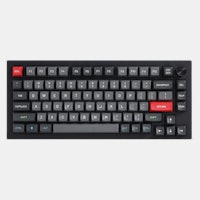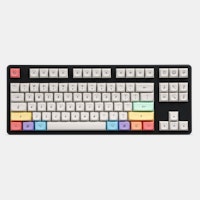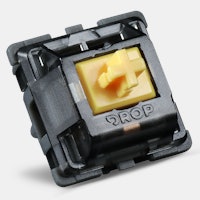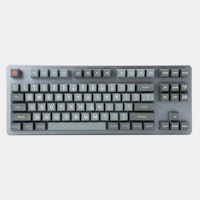Figure 1: Oh yeah, I meant it when I said obscure...
There’s no doubt that mechanical keyboard switches have gotten increasingly better in their stock forms over the past half decade of releases. Despite switches now having tighter manufacturing tolerances, smoother factory lubing, and overall higher quality per dollar spent, aftermarket modifications of switches is still one of the most discussed topics by people freshly joining the hobby today. This hyper fixation on switch modding is due in no small part to the glut of keyboard content creators that produced videos, shorts, and all manner of content during the peak of COVID talking about the art and science behind lubing and filming for switches. For a while there, it almost seemed as if you had to have some content about lubing, filming, and/or ‘frankenswitching’ switches if you wanted to cut it as being a true keyboard content creator in the space. However, as people like this have flooded the internet with increasing amounts of discussion on the easiest and simplest of switch modifications, we’ve truly lost an appreciation for some of the wilder and crazier ideas that people have carried out when it comes to modifying their keyboard switches over the years. In an attempt to prevent these ideas from being lost to the sands of time, here’s a couple of the more ‘out there’ ways that I’ve seen people modify or talk about modifying their keyboard switches over my years of collecting!
-#1. Physically drilling holes into switchesFigure 2: No, seriously.
Conceptually, drilling holes into any part of a keyboard switch in order to modify its sound or some of the interference points between various components seems like a relatively simple idea to carry out. The insanity of this idea, though, quickly comes to the forefront when you recall that switches are less than one cubic inch and volume and often quite fragile pieces of technology to be taking power tools to. And yet despite this mismatch between the size and power of a keyboard switch and power tools, I’ve seen this idea come up on two separate occasions over my time in the keyboard hobby. The first instance where the idea of drilling holes in switches came into some amount of regular discussion was by way of Gazzew’s “Blue Ice” switch bottom housings that he was selling back in 2018. Expanding upon the successes that he had had selling individual switch parts solo back in the days of Outemu Skies, Gazzew went on to offer a series of translucent blue switch bottom housings from Outemu that unfortunately had some poor tolerances regarding their center pole holes in at least one of the batches he had purchased. Not wanting to let this batch go to waste, Gazzew offered 5-mm. drill bits to people purchasing large enough quantities of these switch parts so that they could drill out this center pole hole and effectively “retool” their housings. While this was obviously executed very rarely, there does still exist at least one video online of a former collaborator with Gazzew carrying out this practice himself! The idea of drilling holes in switches also briefly resurged again in late 2023 following the release of Haimu Whisper and Heartbeat switches, which were at the time believed to be silent due to through-switch holes in the bottom housings of the switches in their stock form. Despite this not catching on anywhere nearly as much as Gazzew’s “retooling” work, at least one adventurous user in the SwitchModders Discord attempted this in a pursuit to figure out the true effect of these bottom housings holes.
-#2. Dyeing switches different colorsFigure 3: The very first proof of concept for switch housing dyeing that I could find from Geekhack in 2016.
Despite the very ‘DIY’ heavy nature of this community, and the extreme lengths that people have gone over the years to customize the aesthetics and appearance of their keyboards and keycaps, very little effort has ever been undertaken to manually modify the appearance of switches used in keyboards. While one could easily argue this is due to switches not being able to be seen in the final construction of a keyboard in the same fashion as keycaps or cases, the success over the years of premium, aesthetic-first switches such as the TTC Lunar New Years series or more recently the Hojicha and Matcha Reserve switches from Invokeys begs otherwise. Not content with the limited aesthetic pallet of switches at the time, back in 2016 a GeekHack user by the name of cy384 took on and demonstrated the results of a series of experiments of theirs attempting to dye switches with Rit Dye. In this one and only post, the hobbyist grade plastic dye was used to turn transparent Gateron switch housings into a semi-translucent black colorway that wouldn’t commercially show up in switches until at least 2 years later. Additionally, another user by the name of rpeterclark also demonstrated that iDye brand dye kits were also capable of dyeing clear Gateron stems that of a translucent purple color of their own. While these two trailblazers certainly deserve their spot in history, perhaps the single most compelling proof of concept post of someone dyeing keyboard switches was that of a series of posts on r/mechmarket by Reddit user u/RunTheVoltCoulomb. Not just sticking to the traditional single color dyeing scheme, this user offered and sold out a series of Cherry MX Locks which had had their top housings dyed red, blue, gradients of these colors, and even one very special lock which appeared to be modeled after the US flag as seen at the top of this article. It’s honestly a wonder that we haven’t seen more of this specific niche switch mod after looking at the results of these incredibly gorgeous examples from this user…
Figure 4: More Cherry MX Locks dyed by u/RunTheVoltCoulomb on Reddit
-#3. Leaf swapping
Of all the craziest ideas that have ever been dreamed of in switch modification history, the idea of removing and swapping out the leaves of a traditional, MX-style switch is perhaps the single most unlikely to work for a full batch of keyboard switches. In fact, I’d go as far as to say that I’ve never even heard of anyone ever successfully having done this for more than a single switch at any point in my time in the hobby. On the surface the idea seems quite easy – use some tweezers to pull each of the two leaves in an MX switch out and then simply plug in the leaves from another switch in their place. How hard could it really be? What most people fail to realize until they attempt this exactly one and only one time is that MX leaves are both incredibly fragile and sensitive to being bent in any direction. Even just minorly twisting or bending the leaves in a keyboard switch can altogether remove the tactility from a tactile switch if not altogether completely ruin the functionality of the switch entirely – and this is something that can happen without trying to yank the leaves out! Despite this idea having been around for many, many years on end with a stark lack of success, at least one YouTuber I’ve come across has suggested doing this before so… Maybe one day someone will be insane and patient enough to pull this off for a board-filling set of keyboard switches.
Despite the feasibility of each of these various niche aftermarket switch modifications being questionable, the sheer novelty behind each of these ideas makes them more than worth remembering years after they were initially dreamed up. While there is nothing wrong with the practice of simply lubing and/or filming a set of switches of your own, the wide availability of stock switch options out there truly has stunted some of the creative modification ideas out there that are still left to be unexplored. Perhaps being informed of these modifications will push one of you over the edge into exploring and ultimately discovering the next truly unique way to modify switches. Or, maybe it just makes you want to read more weird stuff about switches. Consider checking out some of my other articles here on Drop such as ‘There Will Never Be Another Project Zealio’ or ‘I Think My Switch Is Stuck! – The Tale of Cherry MX Locks’.





























-#3. Leaf swapping Of all the craziest ideas that have ever been dreamed of in switch modification history, the idea of removing and swapping out the leaves of a traditional, MX-style switch is perhaps the single most unlikely to work for a full batch of keyboard switches. In fact, I’d go as far as to say that I’ve never even heard of anyone ever successfully having done this for more than a single switch at any point in my time in the hobby. On the surface the idea seems quite easy – use some tweezers to pull each of the two leaves in an MX switch out and then simply plug in the leaves from another switch in their place. How hard could it really be? What most people fail to realize until they attempt this exactly one and only one time is that MX leaves are both incredibly fragile and sensitive to being bent in any direction. Even just minorly twisting or bending the leaves in a keyboard switch can altogether remove the tactility from a tactile switch if not altogether completely ruin the functionality of the switch entirely – and this is something that can happen without trying to yank the leaves out! Despite this idea having been around for many, many years on end with a stark lack of success, at least one YouTuber I’ve come across has suggested doing this before so… Maybe one day someone will be insane and patient enough to pull this off for a board-filling set of keyboard switches.
Despite the feasibility of each of these various niche aftermarket switch modifications being questionable, the sheer novelty behind each of these ideas makes them more than worth remembering years after they were initially dreamed up. While there is nothing wrong with the practice of simply lubing and/or filming a set of switches of your own, the wide availability of stock switch options out there truly has stunted some of the creative modification ideas out there that are still left to be unexplored. Perhaps being informed of these modifications will push one of you over the edge into exploring and ultimately discovering the next truly unique way to modify switches. Or, maybe it just makes you want to read more weird stuff about switches. Consider checking out some of my other articles here on Drop such as ‘There Will Never Be Another Project Zealio’ or ‘I Think My Switch Is Stuck! – The Tale of Cherry MX Locks’.